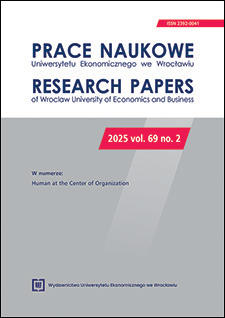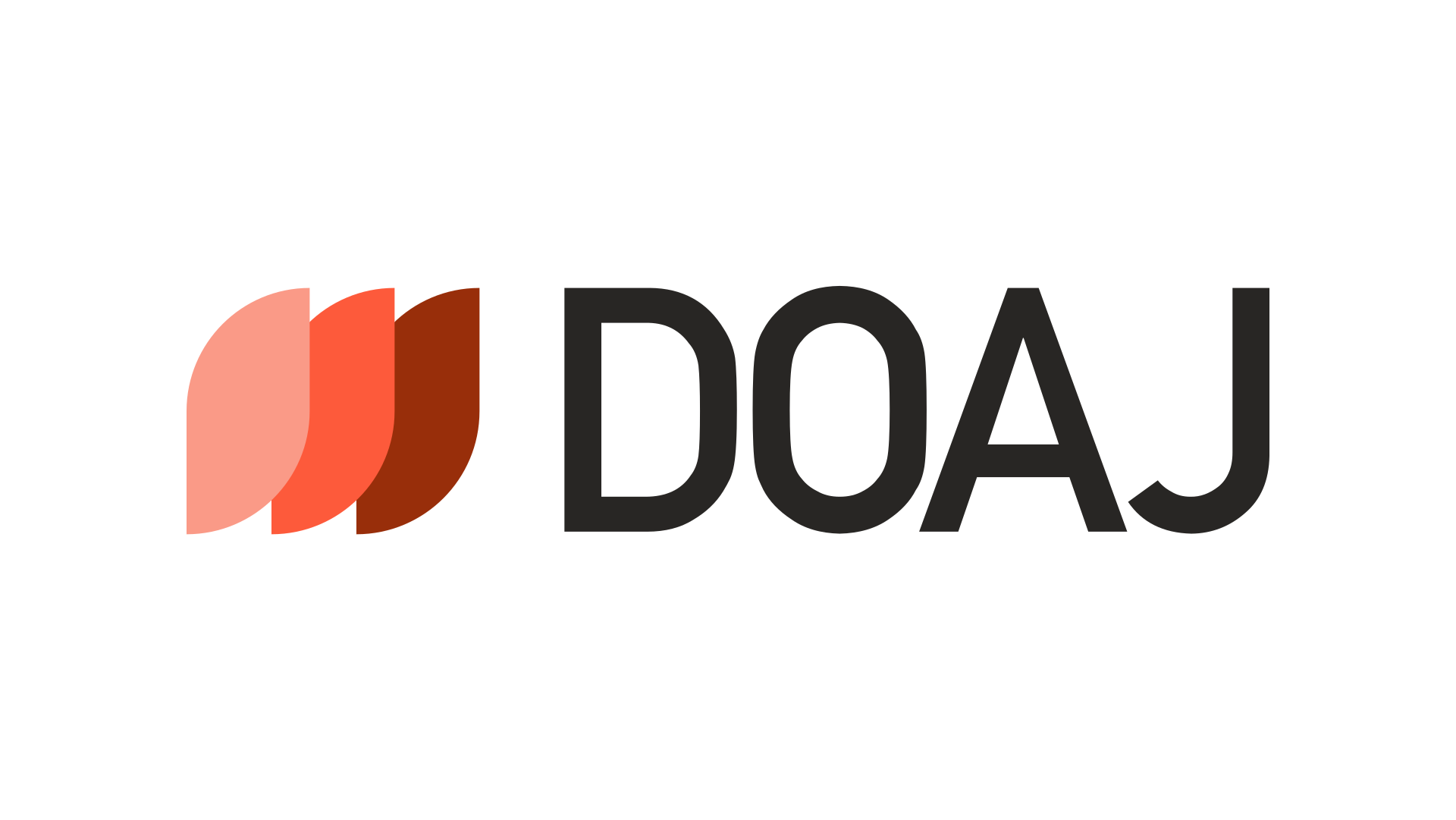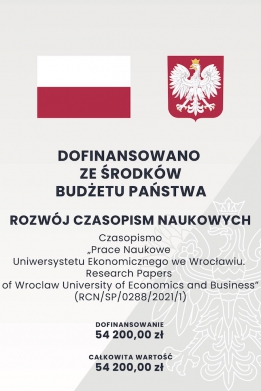The Influence of Age Diversity on Organizational Identification
DOI:
https://doi.org/10.15611/pn.2025.2.13Keywords:
age diversity, organizational identification, workplace attitudes, perceived organizational supportAbstract
Aim: The aim of this study was to determine the role of employee age heterogeneity in building a sense of belonging to the organization and to recognize the impact of human resource management activities and an inclusive climate on this relationship.
Methodology: This study synthesizes the existing literature and presents empirical research conducted in 30 organizations in Poland. Quantitative data were collected from HR managers and rank-and-file employees, and diverse statistical analyses were conducted to verify the hypotheses.
Results: While age diversity alone was not directly related to organizational identification, HR activities supportive of all age groups and a welcoming organizational environment significantly mediated this relationship.
Implications and recommendations: The findings highlight the importance of applying human resource policies inclusive of different age groups and cultivating a welcoming organizational environment to enhance organizational identification. Future research should further explore the mechanisms and contexts in which age diversity impacts organizational identification, considering industry and cultural differences.
Originality/value: This research contributes to the understanding of the dynamics connecting age group variation with identification with the workplace, offering valuable insights for HR management and organizational development in promoting an inclusive and supportive work environment.
Downloads
References
Adjo, J., Maybank, A., & Prakash, V. (2021). Building Inclusive Work Environments. Pediatrics, 148 (Supplement 2).
Ali, M., & French, E. (2019). Age Diversity Management and Organisational Outcomes: The Role of Diversity Perspectives. Human Resource Management Journal, 29(2), 287-307.
Appannah, A., & Biggs, S. (2015). Age-Friendly Organisations: The Role of Organisational Culture and the Participation of Older Workers. Journal of Social Work Practice, 29(1), 37-51.
Avery, D. R., McKay, P. F., & Wilson, D. C. (2007). Engaging the Aging Workforce: The Relationship between Perceived Age Similarity, Satisfaction with Coworkers, and Employee Engagement. Journal of Applied Psychology, 92(6), 1542.
Bal, P. M., & Dorenbosch, L. (2015). Age‐Related Differences in the Relations between Individualised HRM and Organisational Performance: A Large‐Scale Employer Survey. Human Resource Management Journal, 25(1), 41-61.
Baron, R. M., & Kenny, D. A. (1986). The Moderator–Mediator Variable Distinction in Social Psychological Research: Conceptual, Strategic, and Statistical Considerations. Journal of Personality and Social Psychology, 51(6), 1173.
Barrett, J., & Bourke, J. (2013). Managing for Inclusion: Engagement with an Ageing Workforce. Employment Relations Record, 13(1), 13-24.
Bellotti, L., Zaniboni, S., Balducci, C., Menghini, L., Cadiz, D. M., & Toderi, S. (2022). Age Diversity Climate Affecting Individual--Level Work-Related Outcomes. International Journal of Environmental Research and Public Health, 19(5), 3041.
Bergmann, A., Schmidt, S. L., Schreyer, D., & Torgler, B. (2016). Age and Organizational Identification: Empirical Findings from Professional Sports. Applied Economics Letters, 23(10), 718-722.
Boehm, S. A., Baumgaertner, M. K., Dwertmann, D. J., & Kunze, F. (2011). Age Diversity and its Performance Implications –Analysing a Major Future Workforce Trend. From Grey to Silver. Managing the Demographic Change Successfully, 121-141.
Boehm, S. A., & Kunze, F. (2014). Age Diversity and Age Climate in the Workplace. In Aging Workers and the Employee-Employer Relationship (pp. 33-55). Springer International Publishing.
Boehm, S. A., Kunze, F., & Bruch, H. (2014). Spotlight on Age‐Diversity Climate: The Impact of Age‐Inclusive HR Practices on Firm‐Level Outcomes. Personnel Psychology, 67(3), 667-704.
Boekhorst, J. A. (2015). The Role of Authentic Leadership in Fostering Workplace Inclusion: A Social Information Processing Perspective. Human Resource Management, 54(2), 241-264.
Bodla, A. A., Tang, N., Jiang, W., & Tian, L. (2018). Diversity and Creativity in Cross-National Teams: The Role of Team Knowledge Sharing and Inclusive Climate. Journal of Management & Organization, 24(5), 711-729.
Brooke, L., & Taylor, P. (2005). Older Workers and Employment: Managing Age Relations. Ageing & Society, 25(3), 415-429.
Chrobot-Mason, D., & Aramovich, N. P. (2013). The Psychological Benefits of Creating an Affirming Climate for Workplace Diversity. Group & Organization Management, 38(6), 659-689.
Cole, B. M., & Salimath, M. S. (2013). Diversity Identity Management: An Organizational Perspective. Journal of Business Ethics, 116, 151-161.
Dwertmann, D. J., & van Dijk, H. (2020). A Leader’s Guide to Fostering Inclusion by Creating a Positive Diversity Climate. In Inclusive Leadership (pp. 149-161). Routledge.
Ellwart, T., Bündgens, S., & Rack, O. (2013). Managing Knowledge Exchange and Identification in Age Diverse Teams. Journal of Managerial Psychology, 28(7/8), 950-972.
Fan, P., Song, Y., Fang, M., & Chen, X. (2023). Creating an Age-Inclusive Workplace: The Impact of HR Practices on Employee Work Engagement. Journal of Management & Organization, 29(6), 1-19.
Feldman, D. C. (2014). Workforce Diversity in the United States: Challenges and Opportunities for HR Management. Human Resource Management Review, 24(4), 175-185.
Findlay, I. M., & Kowbel, J. (2013). Engaging an Age-Diverse Workplace: Revisiting a Business Opportunity and Challenge. Journal of Business & Financial Affairs, 2(2), 1-2.
Froidevaux, A., Alterman, V., & Wang, M. (2020). Leveraging Aging Workforce and Age Diversity to Achieve Organizational Goals: A Human Resource Management Perspective. In S. Czaja, J. Sharit, & J. James (Eds.), Current and Emerging Trends in Aging and Work (pp. 33-58). Springer.
Goswami, S., & Goswami, B. K. (2018). Exploring the Relationship between Workforce Diversity, Inclusion and Employee Engagement. Drishtikon: A Management Journal, 9(1), 65-89.
Hameed, I., Roques, O., & Ali Arain, G. (2013). Nonlinear Moderating Effect of Tenure on Organizational Identification (OID) and the Subsequent Role of OID in Fostering Readiness for Change. Group & Organization Management, 38(1), 101-127.
Harrison, D. A., & Klein, K. J. (2007). What’s the Difference? Diversity Constructs as Separation, Variety, or Disparity in Organizations. Academy of Management Review, 32(4), 1199-1228.
Hertel, G., IJM Van der Heijden, B., H. de Lange, A., & Deller, J. (2013). Facilitating Age Diversity in Organizations – Part II: Managing Perceptions and Interactions. Journal of Managerial Psychology, 28(7/8), 857-866.
Ingusci, E. (2018). Diversity Climate and Job Crafting: The Role of Age. The Open Psychology Journal, 11, 105-111.
Kembu, A. S., & Nang’oni, W. U. S. (2021). Influence of Age Diversity on Organization Performance at Kenya Urban Roads Authority. Journal of Management Info, 8(4), 220-230.
Klimchak, M., Ward, A. K., Matthews, M., Robbins, K., & Zhang, H. (2019). When Does What Other People Think Matter? The Influence of Age on the Motivators of Organizational Identification. Journal of Business and Psychology, 34, 879-891.
Kossek, E. E., & Zonia, S. C. (1993). Assessing Diversity Climate: A Field Study of Reactions to Employer Efforts to Promote Diversity. Journal of Organizational Behavior, 14(1), 61-81.
Kunze, F., Boehm, S. & Bruch, H. (2011). Age Diversity, Age Discrimination Climate and Performance Consequences – A Cross Organizational Study. Journal of Organizational Behavior, 32(2), 264-290.
Kunze, F., Boehm, S., & Bruch, H. (2013). Organizational Performance Consequences of Age Diversity: Inspecting the Role of Diversity‐-Friendly HR Policies and Top Managers’ Negative Age Stereotypes. Journal of Management Studies, 50(3), 413-442.
Li, Y., Gong, Y., Burmeister, A., Wang, M., Alterman, V., Alonso, A., & Robinson, S. (2021). Leveraging Age Diversity for Organizational Performance: An Intellectual Capital Perspective. Journal of Applied Psychology, 106(1), 71.
Luijters, K., Van der Zee, K. I., & Otten, S. (2008). Cultural Diversity in Organizations: Enhancing Identification by Valuing Differences. International Journal of Intercultural Relations, 32(2), 154-163.
Macdonald, J. L., & Levy, S. R. (2016). Ageism in the Workplace: The Role of Psychosocial Factors in Predicting Job Satisfaction, Commitment, and Engagement. Journal of Social Issues, 72(1), 169-190.
Mael, F., & Ashforth, B. E. (1992). Alumni and Their Alma Mater: A Partial Test of the Reformulated Model of Organizational Identification. Journal of Organizational Behavior, 13(2), 103-123.
Marique, G., Stinglhamber, F., Desmette, D., Caesens, G., & De Zanet, F. (2013). The Relationship between Perceived Organizational Support and Affective Commitment: A Social Identity Perspective. Group & Organization Management, 38(1), 68-100.
McCann, R. M., Kellermann, K., Giles, H., Gallois, C., & Viladot, M. A. (2004). Cultural and Gender Influences on Age Identification. Communication Studies, 55(1), 88-105.
Mor Barak, M. E. (2000). The Inclusive Workplace: An Ecosystems Approach to Diversity Management. Social Work, 45(4), 339-353.
Mor Barak, M. E., Cherin, D. A., & Berkman, S. (1998). Organizational and Personal Dimensions in Diversity Climate. Ethnic and Gender Differences in Employee Perceptions. The Journal of Applied Behavioral Science, 34(1), 82-104.
Neill, M. S., Men, L. R., & Yue, C. A. (2020). How Communication Climate and Organizational Identification Impact Change. Corporate Communications: An International Journal, 25(2), 281-298.
Pinto, A. M. G. L. R. S., da Silva Ramos, S. C. M., & Nunes, S. M. M. D. (2014). Managing an Aging Workforce: What is the Value of Human Resource Management Practices for Different Age Groups of Workers? Tékhne, 12, 58-68.
Rabl, T., & Triana, M. D. C. (2014). Organizational Value for Age Diversity and Potential Applicants’ Organizational Attraction: Individual Attitudes Matter. Journal of Business Ethics, 121, 403-417.
Rezai, M., Lindsay, S., Ahmed, H., & Vijayakumar, A. (2023). Workplace Inclusion: A Scoping Review of the Qualitative Literature. Work, 75(1), 59-73.
Riach, K. (2009) Managing ‘Difference’: Understanding Age Diversity in Practice. Human Resource Management Journal, 19(3), 319-335.
Riach, K. (2011). Situating Age (in) Equality within the Paradigm and Practices of Diversity Management. In E. Parry, & S. Tyson (Eds.), Managing an Age-Diverse workforce (pp. 43-58). Palgrave Macmillan.
Rudolph, C. W., Toomey, E. C., & Baltes, B. B. (2017). Considering Age Diversity in Recruitment and Selection: An Expanded Work Lifespan View of Age Management. The Palgrave Handbook Of Age Diversity And Work, 607-638.
Rudolph, C. W., & Zacher, H. (2021). Age Inclusive Human Resource Practices, Age Diversity Climate, and Work Ability: Exploring Between- and Within-Person Indirect Effects. Work, Aging and Retirement, 7(4), 387-403.
Sammarra, A., Profili, S., Maimone, F., & Gabrielli, G. (2017). Enhancing Knowledge Sharing in Age-Diverse Organizations: The Role of HRM Practices. In Age Diversity in the Workplace (pp. 161-187). Emerald Publishing.
Sammarra, A., Profili, S., Peccei, R., & Innocenti, L. (2021). When is Age Dissimilarity Harmful for Organisational Identification? The Moderating Role of Age Stereotypes and Perceived Age-Related Treatment. Human Relations, 74(6), 869-891.
Shih, M., & Young, M. J. (2016). Identity Management Strategies in Workplaces with Color-Blind Diversity Policies. In A. H. Neville, E. M. Gallardo, & W. D. Sue (Eds.), The Myth of Racial Color Blindness: Manifestations, Dynamics, and Impact. (pp. 261-274). American Psychological Association.
Shih, M., Young, M. J., & Bucher, A. (2013). Working to Reduce the Effects of Discrimination: Identity Management Strategies in Organizations. American Psychologist, 68(3), 145.
Stone, D. L., & Tetrick, L. E. (2013). Understanding and Facilitating Age Diversity in Organizations. Journal of Managerial Psychology, 28(7/8), 725-728.
Teclaw, R., Osatuke, K., Fishman, J., Moore, S. C., & Dyrenforth, S. (2014). Employee Age and Tenure within Organizations: Relationship to Workplace Satisfaction and Workplace Climate Perceptions. The Health Care Manager, 33(1), 4-19.
Verma, A. (2020). Critical Review of Literature of the Impact of Workforce Diversity (Specifically Age, Gender, and Ethnic Diversity) on Organizational Competitiveness. Asian Journal of Management, 11(1), 125-130.
Wolfson, N., Kraiger, K., & Finkelstein, L. (2011). The Relationship between Diversity Climate Perceptions and Workplace Attitudes. The Psychologist-Manager Journal, 14(3), 161-176.
Downloads
Published
License
Copyright (c) 2025 Łucja Waligóra

This work is licensed under a Creative Commons Attribution-ShareAlike 4.0 International License.
Accepted 2025-02-03
Published 2025-07-22









